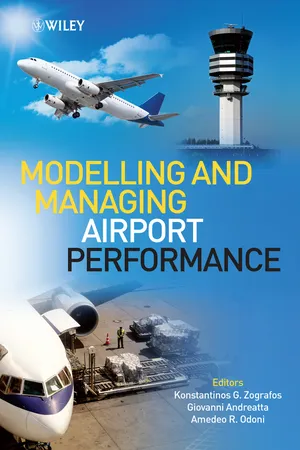![]()
1
Modeling Airport Landside Performance
Anderson Ribeiro CorreiaA and S. C. WirasingheB
A Department of Air Transportation, Aeronautics Institute of Technology, Brazil
B Schulich School of Engineering, University of Calgary, Canada
1.1 Motivation for Level of Service Modeling
The motivation for developing level of service (LOS) measures is twofold. First, given that one of the goals of airport planning is to improve, or at least maintain, the level of service experienced by the airport user, it is necessary to be able to measure LOS in order to know whether this goal is being achieved. Second, airport passenger terminal improvements rarely are without expense. To know whether a particular expenditure is justified it is necessary to be able to measure the change in LOS resulting from it (Gosling, 1988).
Establishing measures to evaluate operational performance of the airport landside and quality of service is one of the major problems facing the airlines and airport operators. Humphreys and Francis (2000) affirm that LOS evaluation in American airports have been undertaken at individual airports, with no standard method or reporting system on a national scale. Research is also needed in developing countries, mainly to generate references for planning airport infrastructure. In this regard, Fernandes and Pacheco (2002) stress that the lack of studies, for example in Brazil, to enable parameters reflecting local conditions to be estimated means that estimates made on the basis of conditions at foreign airports are used without proper evaluation. According to them, the issues of domestic traffic, in particular, deserve special attention in terms of Brazilian specifics.
Airport landside LOS and capacity have been topics of research interest over the past two decades or so. More recently, owing to the critical nature of airport LOS issues, a number of studies have been initiated on the identification of the landside problem in general, and on capacity and service measures in particular. Despite all the airport LOS studies developed in the last two decades, the subject is in a rudimentary state of development in comparison with the status of LOS analysis in highway engineering. In 1986 the FAA responded to concerns of inadequate understanding of landside capacity constraints by commissioning the Transportation Research Board to conduct a study of ways to measure airport landside capacity. This study (TRB, 1987) recognized that the capacity of any given landside facility cannot be evaluated without defining acceptable LOS standards, but that there is currently little agreement on how to do this. Lemer (1988) reviewed the study’s principal findings and recommendations. He concluded that the effort represented a valuable first step toward definitive guidelines for capacity assessment, but that much remained to be done. Thus, the development of appropriate ways to measure airport landside LOS is a critical research need.
The measurement of LOS of airport passenger terminals is also an important issue considering the recent trends for airport privatization and the need for regulation of privatized facilities. There are concerns that efforts to regulate the prices charged by airports can result in under-investment and decline of service standards. In Australia for example, newly privatized airports would be subjected to price regulation in the form of price-caps on aeronautical charges; there is a concern about their effect on the incentive faced by the enterprise to downgrade quality (Forsyth, 1997). This makes it important to monitor not only the cost-efficiency and cost-effectiveness, but also the service effectiveness of airports (Hooper and Hensher, 1997). Gillen and Lall (1997) agree and state that while airports should be asked to adhere to private financial standards, they must also be judged in the context of their overall goals.
This chapter is composed of three main sections. The first section (Airport Landside Components) provides an overview of current LOS standards developed by researchers or industry organizations. Additionally, this section provides basic recommendations for the use of such standards at planning and management levels. The second section (Methodology for Deriving Quantitative Standards for Individual Components) presents a method, based on the psychometric scaling technique, that any airport authority or organization could apply to develop standards. Finally, the third section (Degree of Importance of Landside Components and Attributes) presents a method, based on the Analytical Hierarchy Process, aimed at obtaining the importance that passengers attribute to individual components and attributes. These measures could be used to obtain an overall terminal LOS evaluation.
1.2 Relationship between Measures of Capacity and Level of Service
LOS and capacity measures are intrinsically correlated. Generally, the efficiency of an airport landside component is evaluated by comparing its capacity values with standard measures of the LOS to passengers. In this concern, the IATA (1995), in its airport development reference manual, has proposed LOS standards in order to evaluate the capacity of airport landside components. Some of these LOS standards will be presented in the next sections. Another initiative to evaluate the relationship between LOS and capacity was developed by Brunetta et al. (1999); in that paper, the authors proposed a model, called SLAM (Simple Landside Aggregate Model), in order to measure capacity and to identify reference values for LOS standards.
Since...
